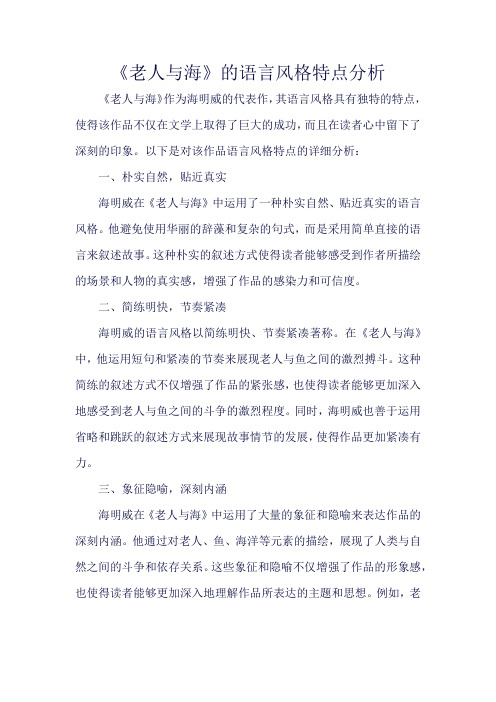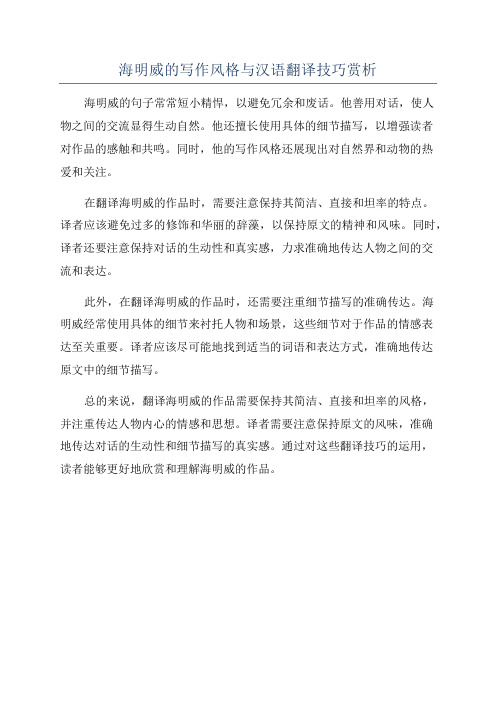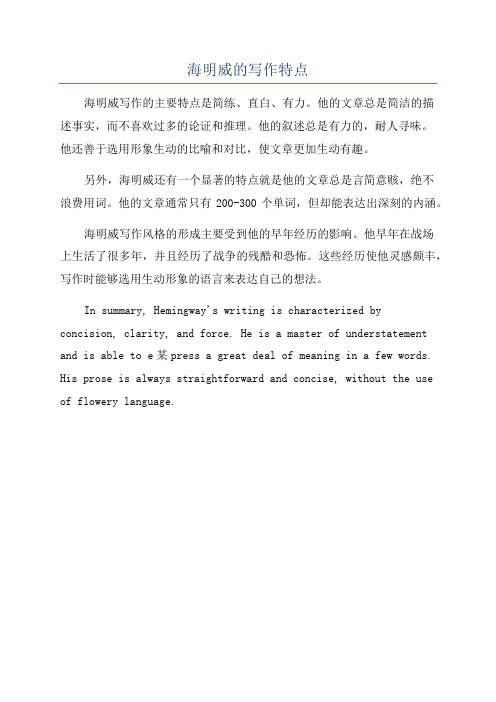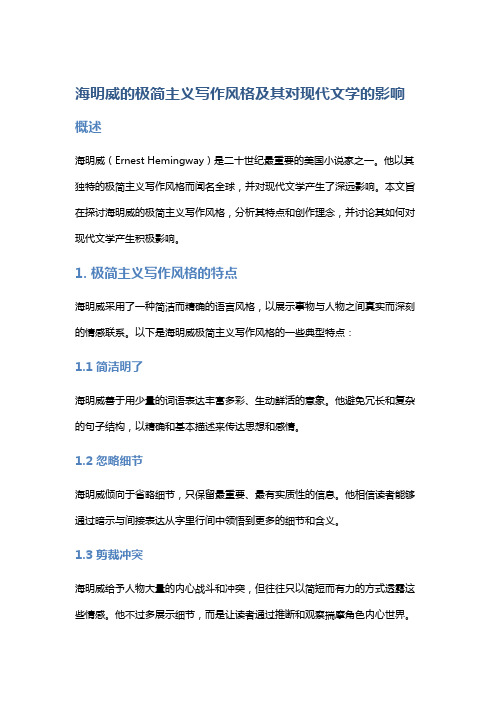海明威写作风格
评《老人与海》中海明威写作风格和手法

评《老人与海》中海明威写作风格和手法【摘要】《老人与海》是海明威的代表作品之一,描写了老渔夫桑提亚哥与一条大马林鱼搏斗的故事。
海明威以简洁明了的文风,真实而质朴的描写,深刻探讨人性,运用象征手法和重复手法,塑造了一个充满哲理和情感的故事。
海明威独特的写作风格使《老人与海》成为一部不朽的文学作品,具有深远的文学价值,对后世文学产生了深远的影响。
通过他对人类意志和勇气的表达,海明威将一位孤独的老渔夫变成了一个永恒的英雄形象,给读者留下了深刻的印象,让人在阅读中感悟到生命的意义和价值。
《老人与海》不仅仅是一部关于打鱼的故事,更是关于生存、信念和坚持的寓言,是一部值得反复品味的经典之作。
【关键词】引言:- 《老人与海》- 海明威的文学地位正文:- 简洁明了的文风- 真实而质朴的描写- 对人性的深刻探讨- 运用象征手法- 重复手法的运用结论:- 海明威独特的写作风格- 《老人与海》的文学价值- 对后世文学的影响1. 引言1.1 介绍《老人与海》《老人与海》是美国文学家海明威于1952年出版的一部小说,被誉为20世纪最伟大的小说之一。
作品讲述了一个老古巴渔夫与一条大马林鱼搏斗的故事,描写了老人与自然、老人与命运、老人与生命的关系。
海明威以简练、朴实的语言风格,展现了他独特的文学魅力。
小说中充满了对人性的探讨和对生命的思考,展现了一种真实而深刻的生活哲学。
通过对老人与海洋的斗争描写,海明威展现了人与自然、人与命运的对抗,表达了对生命意义的追求和对困境的坚韧不拔。
《老人与海》以其深刻的主题、独特的风格、细腻的描写赢得了广泛的赞誉,被视为海明威文学创作的巅峰之作。
这部小说不仅在文学界产生了深远影响,也为后世的文学创作提供了重要的启示和借鉴。
1.2 海明威的文学地位海明威(Ernest Hemingway)是20世纪20年代至40年代间最杰出的作家之一,被誉为“美国文学的巨星”和“现代文学巨人”。
他在文学界的地位是不可撼动的,拥有众多忠实的读者和拥趸。
海明威的写作风格

海明威的写作风格海明威(ErnestHemingway)是二十世纪最著名的作家之一,他的作品以简洁、明快、直白的风格著称。
海明威的写作风格不仅影响了当时的文学界,也对后来的文学创作产生了深远的影响。
本文将从海明威的生平、写作风格、作品特点等方面,对海明威的写作风格进行分析。
一、海明威的生平海明威于1899年7月21日出生在美国伊利诺伊州。
他的父亲是一名医生,母亲是一名音乐家。
海明威的童年比较平静,但他从小就对冒险、运动等活动充满了热情。
在第一次世界大战期间,海明威加入了美国红十字会,在意大利和法国前线担任志愿者。
他的军旅生涯和战争经历深刻地影响了他的写作风格。
二、海明威的写作风格1、简洁明快的语言海明威的写作风格以简洁明快的语言著称,他善于用简单的词汇和短句来表达深刻的思想和情感。
他认为,好的文学作品应该像一条清澈的河流,让读者可以轻松地阅读和理解。
2、战争与人性的主题海明威的作品主要探讨战争和人性的主题。
他通过描写战争的残酷和人性的复杂性,表达了对人类的深刻思考和关注。
他的作品中经常出现的主题包括爱、死亡、荣誉、勇气等。
3、真实感与现实主义海明威的作品以真实感和现实主义著称,他善于通过描写细节来表现人物的内心世界和情感,让读者可以深入感受到作品中所描绘的场景和情境。
4、对话和内心独白海明威的作品中经常出现对话和内心独白,他通过这种方式展现了人物的思想和情感,并且让读者可以更加深入地了解人物的性格和行为。
5、短篇小说和小说集海明威的作品主要包括短篇小说和小说集,他善于用简洁的语言和短小的篇幅来表达深刻的思想和情感。
他的作品中经常出现的主题包括爱、死亡、荣誉、勇气等。
三、海明威的作品特点1、《老人与海》《老人与海》是海明威的代表作之一,它讲述了一个老渔夫孤身一人出海捕鱼的故事。
这个故事充满了对生命的探讨和对人性的思考,同时也表现出了海明威的写作风格和艺术风格。
2、《太阳照常升起》《太阳照常升起》是海明威的另一部经典之作,它讲述了一群美国人在巴黎的生活和情感故事。
海明威风格及其原因分析

海明威风格及其原因分析吴定祥黎裕华文学风格是在一系列作品的内容与形式的有机统一中显示出来的。
海明威独特的文学风格,即/海明威风格0在内容上表现为海明威绝大部分作品都是以战争、拳击、斗牛、狩猎、捕鱼等为题材的,通过这些题材,海明威重复着对四大主题,即爱情、孤独、死亡、抗争的描写;作品中的人物形象是那些面对死亡而毫无惧色的硬汉男性形象和作为检验那些男子气概的场所的或/妖女0、或/天使0的女性形象。
在形式上,/海明威风格0表现为/电报式0对话、简洁传情的景物描写、间接心理描写、外聚焦型视角和象征反讽等修辞手法。
这几个方面相辅相成,有机统一,共同构成了对欧美文坛影响深刻的/海明威式0文体风格。
而独特的/海明威风格0的形成与海明威的个性、成长、经历和所处历史时代等密不可分。
一、海明威的写作风格1954年,当瑞典文学院常务秘书安得思#奥斯特林将诺贝尔文学奖授予厄内斯特#海明威时,评价海明威是他那代人的/风格塑造者0,尤其是他/生动的对话0。
海明威一反以亨利#詹姆斯为代表的浮华、曲折的语言风格而在文坛上独树一帜,他的语言简练生动、凝重深厚。
海明威一生奉行的是他自己提出的/冰山原理0。
他在5死在午后6中说:/如果名散文作家对于他写的内容有足够的了解,他也许会省略他懂的东西,而读者还是会对那些东西有强烈的感觉的,仿佛作家已经点明了一样,如果他是非常真实地写作的话。
一座冰山的仪态之所以庄严,是因为它只有八分之一露出水面。
0作品中用文字直接表现出来的部分是读者所能看见的/露出外面的八分之一0,而隐藏在水下的部分则是八分之七,这样的写作原则使得海明威的语言风格具备了以下两个特点。
1.简洁含蓄性海明威的语言以简洁精练著称,他的文字质朴无华,他尽量少用抽象形容词,少写长句子,海明威运用简单的句子和有限的词汇进行有克制的陈述,渲染气氛,暗示读者文字背后有更重要的东西。
另外,他善于从生活中提取那些能够引起读者与之共鸣的细节,按照适当的顺序加以排列和描写,但是他从不遂节铺陈,而是以简练凝重的笔法,客观地勾勒出个个鲜明的人物形象和幅幅生动逼真的生活图画,他不直接披露自己对篇中人物及事件的态度和看法,而是把自己的表情深深地隐藏在字里行间,让读者去观赏玩味、去探索那/藏在海面以下的八分之七0。
谈谈海明威的文学创作

谈谈海明威的文学创作海明威是美国文坛的一位重量级人物,为世人留下了诸多经典著作。
他的文学风格简洁明了、富于真诚感受和直觉,意蕴深远、情感真挚,享誉世界。
本文将探讨海明威的文学创作。
一、海明威为何成为文学巨匠海明威的文学之路可以追溯到他年少时期的生活经历,青年时期从事战地记者、志愿军等工作,越战中受重伤,种种组合成了创作天赋的源泉。
他的作品借鉴自己的亲身经历,写的是那些鲜活的记忆和深切的情感,读者不仅可以看到故事的情节,还能看到作者想要传达的思想,以及对人性、社会现实的思考和感悟。
同时,他的文学风格也注重简洁明了、情感真挚,结构紧凑,对于读者来说,渐入佳境的体验感呈现得淋漓尽致。
二、海明威的文学创作范围海明威的文学创作领域涉及小说、散文、历史、剧本等多个方面。
其中,他的小说创作尤受称赞。
早期的作品《太阳照样升起》、《丧钟为谁而鸣》等,描写了欧美社交圈儿和人际关系的咨询错综复杂、透露着复杂的内心交织。
到了后期,他的作品则更加着重于战争和硬汉主义的主题,例如《丧钟在为谁鸣》、《分手的时候,看得见河流》等。
他的表现手法则是采用简洁明了、语言干瘦的句子,将阅读体验完全的压入到人物实际情感和生活感受中去。
三、海明威的文学风格海明威的文学风格在美国文学史上独树一帜,其作品具有简洁明了、精辟有力、感情真挚、表现力强等特点。
写作时他巧妙地运用语言,铺陈叙述的节奏刚好带动读者的情绪,时而让人感到轻松愉悦、时而让人感到沉重压抑。
他的语言运用也非常有特色,不拘泥于千篇一律的辞藻,经常使用一些比喻和暗示的技巧,给人以丰富多彩的联想。
他的作品数量不多,但每一篇小说都可以称得上是名作。
四、海明威的文学精神海明威的作品不仅仅是经典小说,还是他对人性、对生命和世界的观察和思考。
他的作品中充满了对人类生存及其意义的思考和探索,表现了对世界的关怀和对历史的思索。
海明威在创作中追求的是表现出真实的人性和社会现实,并力图深刻地反映出当时的历史和人类情感的变化。
浅析海明威《老人与海》的艺术风格

浅析海明威《老人与海》的艺术风格
海明威的《老人与海》是一部经典的文学作品,它的艺术风格具有以下几个特点。
首先,简洁明快。
海明威在写作中追求简洁明快的风格,他的语言简明直接,没有多余的修饰和废话。
他使用简短的句子和精确的词语来表达观点,使整个故事流畅而有力。
这种简洁明快的风格使读者能够更好地沉浸在故事情节中,感受到故事的紧凑和紧张。
其次,真实自然。
海明威以真实自然的写作风格著称,他的小说展示了真实世界中的人物和情节。
他通过细致入微的描写,使读者能够感受到故事中的真实情感和真实场景。
他的描述不加修饰和夸张,使读者能够更加真实地理解和感受故事中人物的思想和感情。
第三,富有哲理。
《老人与海》是一部深层次的作品,它探讨了人类意志和命运的问题。
海明威通过老人桑地亚哥的冒险经历,描绘了人与自然之间的斗争和人生的意义。
他通过在故事中使用象征、隐喻和对比等修辞手法,传达了深刻的内涵和哲理。
这种富有哲理的风格使读者在欣赏作品的同时,也能够思考人生的意义和价值。
充满力量和情感。
《老人与海》是一部充满力量和情感的小说。
通过老人桑地亚哥在大海中与巨鲨搏斗的描写,海明威展现了人类决心和毅力的力量,并表达了对生命的热爱和对困境的坚持。
他的语言充满激情和感情,使读者能够深切地感受到故事
主人公的心灵与生命的挣扎。
海明威的《老人与海》具有简洁明快、真实自然、富有哲理和充满力量和情感等艺术风格。
这些风格使作品成为一部经典之作,深受读者的喜爱和赞赏。
赏析《老人与海》的语言风格

《老人与海》的语言风格特点分析《老人与海》作为海明威的代表作,其语言风格具有独特的特点,使得该作品不仅在文学上取得了巨大的成功,而且在读者心中留下了深刻的印象。
以下是对该作品语言风格特点的详细分析:一、朴实自然,贴近真实海明威在《老人与海》中运用了一种朴实自然、贴近真实的语言风格。
他避免使用华丽的辞藻和复杂的句式,而是采用简单直接的语言来叙述故事。
这种朴实的叙述方式使得读者能够感受到作者所描绘的场景和人物的真实感,增强了作品的感染力和可信度。
二、简练明快,节奏紧凑海明威的语言风格以简练明快、节奏紧凑著称。
在《老人与海》中,他运用短句和紧凑的节奏来展现老人与鱼之间的激烈搏斗。
这种简练的叙述方式不仅增强了作品的紧张感,也使得读者能够更加深入地感受到老人与鱼之间的斗争的激烈程度。
同时,海明威也善于运用省略和跳跃的叙述方式来展现故事情节的发展,使得作品更加紧凑有力。
三、象征隐喻,深刻内涵海明威在《老人与海》中运用了大量的象征和隐喻来表达作品的深刻内涵。
他通过对老人、鱼、海洋等元素的描绘,展现了人类与自然之间的斗争和依存关系。
这些象征和隐喻不仅增强了作品的形象感,也使得读者能够更加深入地理解作品所表达的主题和思想。
例如,老人与大鱼的搏斗可以看作是人类与自然之间的斗争,而老人最终战胜大鱼则表达了人类对自然的征服和胜利。
四、心理描写,细腻深刻海明威在《老人与海》中进行了细腻深刻的心理描写。
他通过对老人的内心独白、梦境和幻觉的描绘,展现了老人的内心世界和思想情感。
这种心理描写不仅增强了作品的感染力,也使得读者能够更加深入地了解老人的性格、经历和信仰。
同时,海明威也善于运用心理描写来展现人物之间的矛盾和冲突,增强了作品的张力和表现力。
五、口语化风格,亲切感人海明威的语言风格具有口语化的特点,这使得他的作品更加亲切感人。
《老人与海》中的对话运用了口语化的表达方式,使得读者能够感受到人物之间的真实交流和情感交流。
这种口语化的风格也使得作品更加易于理解和接受,增强了作品的感染力和可读性。
著名作家海明威的写作风格是什么

著名作家海明威的写作风格是什么著名作家海明威的写作风格是什么海明威的作品标志着他独特创作风格的形成,在美国文学史乃至世界文学史上都占有重要地位。
以下是店铺精心整理的海明威的写作风格介绍,希望能帮到大家!著名作家海明威的写作风格是什么篇1海明威的写作风格可以从三个角度来赏析海明威写作风格。
首先是海明威的语言风格,在创作中,他所使用的词语都不是很华丽的词语,他追寻的是一种朴实硬朗的风格,所使用的词语大多都会体现出一种硬汉刚硬的形象。
在文章中,海明威很少使用形容词,只是将普通的场景用普通但是强有力的名词来表现。
这个可以反映出海明威语言风格中质朴又真实的一面。
在质朴的同时,也描绘了很直观的画面。
海明威在强调文章的客观性的同时还会委婉地表达出所要表达的深层思想,即便文字朴素,但内在感情同样可以表达出来。
海明威在创作中会使用不同工作领域的人所使用的特有语言,这同样十分吸引读者,可以带给读者一种真正具备语言功效的幻觉。
从而给读者一种身临其境的感觉。
其次,海明威还十分擅长使用对话的方式来创作,这种对话的表达方式,不仅简洁易懂,而且还能将文中的内容表达的更为彻底,这也成为了海明威写作特点的.一个独特之处。
最后,海明威作品中的男女在结局的时候总会分离。
而这种分离有许多不可抗拒的因素,像意外死亡,或者男性自身的一些缺陷等等。
总之海明威的作品结局一般都是悲剧。
海明威写作风格也隐晦地表达出了海明威内心的想法,这就是他和女人生活在一起时间一久就会有一种莫名的恐惧感。
海明威站着写作的原因海明威是二十世纪的美国一个非常具有代表性的作家,也是一个非常典型的人物,这在他的小说中有非常明显的体现。
而海明威在创作的时候,有一个习惯是让大家非常奇怪的,那就是海明威是站着写作的,并且是单脚站立写作的。
那么,海明威为什么站着写作呢?关于海明威为什么站着写作这一问题,曾经有记者在采访海明威的时候有提到过。
海明威给记者的回答是,这样写作可以更快。
海明威作品的写作风格及其理论基础

海明威作品的写作风格及其理论基础海明威的写作风格:简练直观、擅长短篇创作、情感含蓄、朴实、极少比喻和说明。
简练直观:海明威曾经的记者的经历教会他如何使用短句和简洁的段落表达,并使用积极和正面的语言。
少用形容词、抽象名词、复杂语法结构,这样更易理解。
擅长短篇:他从不写长篇,他只截取故事的一个时间段或一个时间点,以集中反映重大的主题或历史事件。
至于故事经过和背景,则当作冰山的八之七隐于海洋之下,但他又要让读者强烈地感到它的存在。
情感含蓄:海明威很少直接对事件做出评论和解释,他只通过客观的叙述、事物感情的描述,融入自己对事件自然平和的说明,给读者仅仅一个描述性的表达,如冰山海面上的八分之一,其他部分让读者自己感受和理解。
朴实:海明威所创造出的小说中的人物不是靠技巧和想象编造出来的角色。
他们必须是出自作者自己经过融化了的切身体验,出自他的知识,出自他的头脑,出自他的内心,出自一切他身上的东西。
为此,他摒弃那种渲染人物的华丽辞藻,删去一般认为必不可少的说明和议论以及一切冗赘的比喻,破除毫无生气的文章俗套,以简洁洗练的文笔还给文章以本来面目。
扩展资料:人物简介欧内斯特·米勒尔·海明威,出生于美国伊利诺伊州芝加哥市郊区奥克帕克,美国作家、记者,被认为是20世纪最著名的小说家之一。
海明威被誉为美利坚民族的精神丰碑,并且是“新闻体”小说的创始人,他的笔锋一向以“文坛硬汉”著称。
海明威的生平和文学生涯从一开始就争议不断。
无论海明威是作为一位传奇式人物,还是作为一位作家,他以其独特的艺术风格和高超的写作技巧创造了一种简洁流畅、清新洗练的文体,净化了一代的传统文风,在欧美文学界产生了巨大的影响。
海明威一生中的感情错综复杂,先后结过四次婚,是美国“迷惘的一代”中的代表人物,作品中对人生、世界、社会都表现出了迷茫和彷徨。
海明威的作品标志着他独特创作风格的形成,在美国文学史乃至世界文学史上都占有重要地位。
海明威的写作风格与汉语翻译技巧赏析

海明威的写作风格与汉语翻译技巧赏析海明威的句子常常短小精悍,以避免冗余和废话。
他善用对话,使人
物之间的交流显得生动自然。
他还擅长使用具体的细节描写,以增强读者
对作品的感触和共鸣。
同时,他的写作风格还展现出对自然界和动物的热
爱和关注。
在翻译海明威的作品时,需要注意保持其简洁、直接和坦率的特点。
译者应该避免过多的修饰和华丽的辞藻,以保持原文的精神和风味。
同时,译者还要注意保持对话的生动性和真实感,力求准确地传达人物之间的交
流和表达。
此外,在翻译海明威的作品时,还需要注重细节描写的准确传达。
海
明威经常使用具体的细节来衬托人物和场景,这些细节对于作品的情感表
达至关重要。
译者应该尽可能地找到适当的词语和表达方式,准确地传达
原文中的细节描写。
总的来说,翻译海明威的作品需要保持其简洁、直接和坦率的风格,
并注重传达人物内心的情感和思想。
译者需要注意保持原文的风味,准确
地传达对话的生动性和细节描写的真实感。
通过对这些翻译技巧的运用,
读者能够更好地欣赏和理解海明威的作品。
海明威的写作手法

海明威的写作手法
海明威是20世纪最著名的作家之一,他的写作手法独特而引人注目。
以下是他的一些写作手法:
1. 简洁明了的语言:海明威的作品通常使用简洁明了的语言,强调语言的直白和清晰。
他喜欢使用简单的词汇和短句,使读者能够更快地理解他想表达的意思。
2. 强调人物的情感和心理状态:海明威喜欢描写人物的情感和心理状态,尤其是在人物内心的矛盾和挣扎方面。
他的文字通常充满了感性的表达方式,让读者能够更深入地理解人物的内心世界。
3. 重视自然环境:海明威的写作手法之一是重视自然环境的表现。
他善于描写大自然中的细节,如阳光、月色、微风、海浪等,这些元素可以帮助读者更好地理解人物的情感和心理状态。
4. 采用对比手法:海明威经常采用对比手法,以人物之间或事物之间的对比来突出主题。
比如,他用不同的角度和场景来描写同一人物,通过对比来增强读者对人物的认识。
5. 独特的叙事方式:海明威的叙事方式独具一格,他经常采用跳跃式叙述和非线性叙述等手法,使故事更加复杂和有趣。
海明威的写作手法独特而多样,强调语言的准确性和直接性,同时也注重人物情感和心理状态的描写,自然环境的表现和对比,以及叙事方式的独特性。
这些特点帮助他成为了20世纪最伟大的作家之一。
海明威冰山风格名词解释

海明威冰山风格名词解释
海明威冰山风格是指美国作家欧内斯特·海明威在其文学作品中采用的独特写作风格。
这种风格以简洁、明快、真实、不加修饰的叙述方式而闻名。
海明威的写作风格更偏向于“省略”而非“累赘”,他通过去除多余的修饰和冗长的句子,以及使用简洁的词汇和直接的对话,展现了深藏情感的力量。
他像冰山一样,只展示出水面上一小部分,而隐藏着更加庞大的内在世界。
海明威冰山风格的另一个特点是他善于运用对比和象征,以及通过片刻的细节来突出故事的主题。
他通常选择用简短的句子和段落来揭示角色的情感和思想,读者需要通过细心阅读和品味来理解他真正想要传达的意义。
这种风格的杰出代表作品包括《老人与海》、《丧钟为谁而鸣》和《太阳照常升起》等。
海明威通过这些作品展现了生活的辛酸与坚韧、人性的复杂与脆弱,以及对战争、人类关系和自我探索的思考。
海明威冰山风格的影响深远,不仅为后来的作家提供了启示,也让读者在阅读中感受到真实与深度。
他通过简洁的写作风格探索了人类存在的本质,留下了不可磨灭的文学遗产。
海明威小说的叙事艺术

海明威小说的叙事艺术海明威小说的叙事艺术海明威(Ernest Hemingway)是美国文学史上最杰出的作家之一,他以其独特的叙事风格和简明扼要的语言而闻名于世。
他的作品通过独特的叙事艺术,深深打动了无数读者。
本文将探讨海明威小说中的叙事艺术,探寻其独特之处以及作品中所表达的主题。
首先,海明威的叙事方式以简洁、明晰和直接而著称。
他用简明扼要的语言描述事件,避免冗长的描写和装饰。
他的叙述风格更接近于击鼓文风,以最短的篇幅表达最深刻的意义。
这种简洁明了的叙事风格使读者能够更好地投入到故事情节中,而不受多余修饰的干扰。
例如,在他的代表作《老人与海》中,他用简单的句子和常见的词语,将老渔夫与大海之间的挑战和战斗展现得淋漓尽致,使读者能够充分地感受到角色内心的痛苦和追求。
其次,海明威的叙事风格非常注重现实主义描写。
他对细节的关注度十分高,时时刻刻将读者带入故事中的真实感受。
他经常使用典型的具体形象和动作描写来展示人物的性格和情感。
他的叙述方式让读者能够感受到故事中的细微变化和复杂情感。
例如,在《战争与和平》中,他以战争为背景,通过描写士兵们日常生活中的琐碎细节,展现出他们所经历的恐惧、战斗和牺牲。
此外,海明威的叙事风格强调节奏和情感的对比。
他善于在不同场景之间进行切换,通过节奏的变化和对比来增强叙事的张力。
他经常使用快速、紧凑的语言来描绘紧张的情节,然后将之与慢节奏的描写相结合,形成对比。
这种叙事方式使读者感受到情节的紧张和战斗氛围,同时也体会到角色内心的矛盾与挣扎。
例如,在他的作品《午后之死》中,他通过精确的语言和情节安排,将主人公的内心矛盾和外部冲突有机结合,让读者跟随着主人公的情感起伏,体验到他所经历的心灵挣扎。
最后,海明威的叙事艺术中不乏人生哲理和存在主义思想。
他通过对生死、爱情、战争等主题的描写,向读者传递一种思考和反思的力量。
他的作品经常涉及到人类生存的困境和意义,通过描述人物的行为和选择揭示人性的复杂性。
海明威的写作特点

海明威的写作特点
海明威写作的主要特点是简练、直白、有力。
他的文章总是简洁的描
述事实,而不喜欢过多的论证和推理。
他的叙述总是有力的,耐人寻味。
他还善于选用形象生动的比喻和对比,使文章更加生动有趣。
另外,海明威还有一个显著的特点就是他的文章总是言简意赅,绝不
浪费用词。
他的文章通常只有200-300个单词,但却能表达出深刻的内涵。
海明威写作风格的形成主要受到他的早年经历的影响。
他早年在战场
上生活了很多年,并且经历了战争的残酷和恐怖。
这些经历使他灵感颇丰,写作时能够选用生动形象的语言来表达自己的想法。
In summary, Hemingway's writing is characterized by concision, clarity, and force. He is a master of understatement and is able to e某press a great deal of meaning in a few words. His prose is always straightforward and concise, without the use of flowery language.。
in another country写作风格

in another country写作风格《In Another Country》是海明威在1927年所写的一篇短篇小说。
这篇小说的主题是战争和失落,被认为是海明威最令人深思熟虑的作品之一。
在写作风格方面,,海明威以简短、干净、无废话的笔触著称,有着鲜明的个性和风格。
本文将探讨海明威在《In Another Country》中的写作风格。
首先,海明威的写作风格是简约而精致的。
他不使用不必要的修辞和繁琐的表达,而是使用简单的语言和简洁的句子传达信息。
这样的简明风格在小说中表现得淋漓尽致。
例如,当主人公试图重新学习基本的活动时,他用简短的句子描述了他们尝试运动的失败:“我们都转了一百多圈,转了好几个小时。
我们试过了那些练习,没有一个成功。
”这些句子虽简单,但信息传达得很清晰,使读者直接了解主人公的挣扎和沮丧。
其次,海明威的写作风格注重细节。
在《In Another Country》中,他描述了医院内部的环境和情景。
这些细节有助于增强读者对主人公情感困扰的了解,并且让读者感受到强烈的医院气氛。
当主人公与教练交谈时,背景细节描绘了破旧的墙壁和刻有壁龛的大理石地面。
这些细节让读者更加容易地想象出背景和情景,并引起读者的共鸣。
第三,海明威的写作风格充满了情感。
虽然他的语言和句式简单,但他在小说中通过生动的场景和情节,深刻地揭示了主人公内心的情感。
通过主人公的独白,读者了解到他的思想和情感。
例如,当主人公宣布放弃恢复运动能力时,他的内心感到十分沮丧和失望:“我无声地离开他,步行回到酒店。
我是非常沮丧的。
世界上所有的美好东西都已离我远去,就像舞蹈一样,就像生命一样,就像爱一样。
”通过这些情感,读者能够深入地理解主人公的痛苦和失落。
最后,海明威的小说中有很强的思想性质。
他不仅关注故事发生的时间和地点,也探索人物内心的情感和思想。
因此,他的故事不仅仅是旁观者看到的画面,还有着深刻的哲学思考。
当主人公宣布退出治疗时,他的话语掩盖着强烈的绝望和失望。
《海明威的极简主义写作风格及其对现代文学的影响》

海明威的极简主义写作风格及其对现代文学的影响概述海明威(Ernest Hemingway)是二十世纪最重要的美国小说家之一。
他以其独特的极简主义写作风格而闻名全球,并对现代文学产生了深远影响。
本文旨在探讨海明威的极简主义写作风格,分析其特点和创作理念,并讨论其如何对现代文学产生积极影响。
1. 极简主义写作风格的特点海明威采用了一种简洁而精确的语言风格,以展示事物与人物之间真实而深刻的情感联系。
以下是海明威极简主义写作风格的一些典型特点:1.1 简洁明了海明威善于用少量的词语表达丰富多彩、生动鲜活的意象。
他避免冗长和复杂的句子结构,以精确和基本描述来传达思想和感情。
1.2 忽略细节海明威倾向于省略细节,只保留最重要、最有实质性的信息。
他相信读者能够通过暗示与间接表达从字里行间中领悟到更多的细节和含义。
1.3 剪裁冲突海明威给予人物大量的内心战斗和冲突,但往往只以简短而有力的方式透露这些情感。
他不过多展示细节,而是让读者通过推断和观察揣摩角色内心世界。
1.4 直击主题海明威的作品通常以一个简单、清晰的主题为核心。
他将重点放在故事情节和深层次思考上,通过写实、现实主义的叙事方法来传递哲学意义。
2. 海明威极简主义写作风格对现代文学的影响2.1 影响另类写作流派海明威对于许多后来出现的文学流派,特别是脚下现代派和后现代派产生了深远影响。
他的简洁而富有诗意的句子结构以及对细节审视和省略的处理方式,启发了许多作家创造出独特、非传统的叙事风格。
2.2 强调内心体验海明威经常探索人性的复杂性和内心的挣扎,他的作品对于现代文学中的自我意识和内在体验有着巨大影响。
许多现代作家从海明威那里汲取灵感,并通过书写个人内心世界来建构角色并展示情感状态。
2.3 启发生活真实海明威通过描绘日常生活中普通人物的故事,强调真实和直接的体验。
这种真实主义的叙事方式激发了许多作家去探索现实生活、底层社会以及社会问题,从而推动了现代文学的进一步发展。
海明威写作特点

海明威写作特点
1、海明威有着出色的语言驾驭能力,他常以最简单的词汇表达最复杂的内容,用基本词汇、简短句式等表达具体含义,用名词、动词来揭示事物的本来面目,丝毫无矫揉造作之感。
2、海明威用高度清晰的视觉化语言,将视觉、嗅觉、听觉等感官印象付诸语言,写出了事物的形状、颜色、味道等,以直接的物象表现宇宙与生命。
3、海明威有自己特殊的艺术风格,他强调写作的客观性与主题思想的隐晦含蓄,反对作者直接出场对人物进行评说与暗示,他常用含蓄的语言表达复杂的情感,用有限的形式表达无尽的内涵,因而,他的小说在外观不动声色,但内在情感却是丰厚炽热。
4、从叙事的方式来看,海明威的小说的对话是“展示”,而不是“讲述”。
它是属于柏拉图所区分的“完美模仿”的一种,而不是“纯叙事”的那种,它想造成一种程度不同的“模仿错觉”,就是“诗人竭力造成不是他本人在说话”,而是某一个人物在说话的假象。
5、从男女关系的主题去分析海明威,不难看出,尽管热衷于描写男人的野性与英勇,海明威却间接表现了他对女人的恐惧与憎恨。
海明威的作品风格分析

海明威的作品风格分析一、海明威的作品风格特点海明威,美国著名作家,以其独特的写作风格和深刻的情感描写而闻名于世。
他的作品常常流露出简洁、直接和真实的特点,引起了读者们的广泛关注。
本文将从以下几个方面来分析海明威作品的风格特点。
1. 简约而直接一个显著的特点是海明威作品中短小精悍、字句简约而直接。
他倾向于用简单明了的语言来表达自己想要传达给读者的信息。
例如,在《丧钟为谁而鸣》中,他使用了极少量修饰词,使故事更加紧凑有力、生动自然。
这种简洁而直白的方式使得读者能够快速深入地理解故事,并体会到其中所蕴含的情感。
2. 不断强调真实与现实海明威关注现实生活中存在的问题和挑战,并通过他笔下世界各地各行各业中普通人物角色展示人性与命运等主题。
以《老人与海》为例,讲述了一个栩栩如生的古巴老渔夫与他困境中的奋斗。
海明威通过对细节的精确描写,以及对渔夫思想和情感的真实展示,使得读者能够深刻地理解和感受到人类存在的困境与挣扎。
3. 冷静而深邃的观察力海明威以其冷静而深邃的观察力,塑造了许多引人入胜的角色。
他对人物内心动机和情感状态开展了独到的刻画,并将这些隐秘而复杂的情感巧妙地通过故事情节表达出来。
在《归来无期》中,他描述了一个战争英雄在旅途中失去信仰、变得心灵空虚而迷茫的过程。
通过平静而准确地揭示主角内心世界中存在着复杂纠结与痛苦,海明威成功营造出一种恢宏壮丽、耐人寻味的氛围。
4. 淡化个人感情尽管个人情感存在于作品之中,但是海明威通过诸如间接性谈话、突发事件等手法将它们置于次要位置。
他更加关注人类存在的共同经历和普遍价值,并且以此来探寻生命中的真谛。
例如,《别为我哭泣》中,主角表面乐观坚强,但内心却充满对战争残酷现实的痛苦和追求和平的渴望。
海明威通过这种方式将个人情感融入到整个作品中,使之具有深刻而广泛的影响力。
二、海明威的写作风格带来的影响海明威独特的写作风格不仅让他成为美国现代文学史上一位重要的创作家,同时也对当代文学及其他领域产生了广泛而深远的影响。
海明威的语言风格

海明威的语言风格海明威的语言风格:一种淡泊而真实的叙述方式在文学史上,海明威被誉为美国现代文学的巨匠之一。
他的作品以简洁、真实而著称,他的语言风格独特而富有力量。
海明威的文字像一抹清泉,流淌在读者的心灵深处,给人以清新、真实的感受。
海明威的语言风格首先体现在他的句式上。
他善于使用简单而有力的句子,通过短小的词汇表达出复杂的情感和思想。
他的句子简洁明快,没有多余的修饰词,让读者能够直接感受到文字的力量。
例如,他在《老人与海》中写道:“大海是无情的,但也是公平的。
”这句简单的话语中蕴含着深刻的哲理,让人不禁陷入对生命、命运的思考。
海明威的叙述方式也很独特。
他善于通过细腻而生动的描写,将读者带入他笔下的世界。
他的描写语言简练,但却能准确地传达出事物的细节和情感。
例如,在《丧钟为谁而鸣》中,他用简洁的文字描绘了一个破败的小村庄,读者仿佛能够看到那些老旧的房屋和黯淡的街道。
海明威的描写让人感受到了真实世界的残酷和荒凉,也让人产生了对生命的思考和珍惜。
海明威的语言风格还体现在他对细节的关注。
他善于捕捉生活中的细微之处,通过对细节的描写来展现人物的性格和情感。
他的文字细腻而真实,让人感到仿佛亲身经历了故事中的一切。
例如,在《在静安场》中,他通过对小女孩的描写,展现了她的天真和聪明,让读者感受到了这个孩子的可爱和真实。
海明威的语言风格也体现在他对人物内心世界的揭示上。
他通过对人物的思想和情感的描写,展现了人物的复杂性和矛盾性。
他的文字真实而深刻,让读者能够感受到人物内心的痛苦和欢乐。
例如,在《别为我哭泣》中,他通过对主人公内心的描写,展现了他对战争的恐惧和对生命的珍视。
海明威通过对人物内心的描写,使人物更加真实和可信,让读者能够更好地理解和共鸣。
海明威的语言风格淡泊而真实,他的文字充满了人类的情感和思考。
他通过简洁而有力的句子、细腻而真实的描写、对细节的关注以及对人物内心世界的揭示,将读者带入他的故事中,让读者感受到真实世界的残酷和美好。
海明威《在异乡》的叙事艺术和文体风格

海明威《在异乡》的叙事艺术和文体风格海明威是美国文学史上的重要作家之一,他的作品以其独特的叙事艺术和独特的文体风格而闻名。
其中,《在异乡》是他的一部重要作品,本文将从叙事艺术和文体风格两方面对该作品进行探讨。
一、叙事艺术1. 简洁而生动的描写海明威以简洁而生动的描写闻名,这种叙事艺术在《在异乡》中得到了充分展现。
他通过对细节的把握和精准的语言选择,塑造了生动的场景和形象,使读者能够身临其境地感受到故事中的情节和人物。
2. 剪裁和省略的手法海明威的叙事风格注重剪裁和省略,他通过删除冗长的描写和多余的细节,使故事更加紧凑和凝练。
他善于运用略语和省略语句,使读者在有限的文字中感受到更多的内涵和情感。
3. 多角度的叙事视角《在异乡》中的叙事视角多样,这也是海明威叙事艺术的一大特点。
他经常通过不同人物的视角和内心独白来展现故事,使读者能够深入了解各个角色的思想和情感,同时也增加了故事的深度和复杂性。
二、文体风格1. 简练而有力的语言海明威的文体风格以简练而有力的语言为主,他注重句式的平衡和语言的节奏感。
他的句子通常较短,词汇简洁明了,但却能够表达出深刻的思想和情感,给人一种力量感和独特的节奏感。
2. 对话的运用海明威擅长运用对话来表达人物之间的关系和情感。
他的对话通常简短明了,富有真实感和戏剧性,能够准确地展现人物的性格和内心世界。
海明威通过对话的运用,使读者更好地理解故事和人物。
3. 冷静而深邃的笔触海明威的文体风格冷静而深邃,他通过对细节和情感的精准把握,展现了人物内心的挣扎和思考。
他注重描写情感的冷静表达,使得读者在冷静的文字中感受到更多的情绪和共鸣。
总结:海明威的《在异乡》通过其独特的叙事艺术和文体风格给读者带来了深刻的阅读体验。
他以简洁凝练的语言、剪裁和省略的手法、多角度的叙事视角等方式展示了故事中的精彩情节和人物形象。
同时,他的文体风格以简练有力的语言、对话的运用和冷静深邃的笔触为主,使读者能够深入思考和感受到故事中的情感和内涵。
冰山风格名词解释

冰山风格名词解释冰山风格,又称冰山理论,是20世纪初美国小说家海明威提出的文学风格概念。
它主张作品中只展示事物的表面现象,将大部分细节和内在情感留给读者自行揣摩。
冰山风格强调文字简洁、干净利落,不做多余修饰和描写,强调真实、客观的揭示事物的本质和真实性。
冰山风格的名字来源于海明威的一句名言:“小冰山只露出海面的一角,读者能根据这个角度判断出整个冰山的规模。
”冰山仅露出水面的一小部分,大部分被深海所掩盖,这象征着冰山风格的基本原则,即作品只展示事物的表面,而将深层的意义和内在情感留给读者去体会。
冰山风格强调简洁明了的语言表达,反对文学的浮华修辞和繁琐描写。
作者要力求用简练的语言把故事讲完,让读者通过碎片化的细节和字里行间的间接暗示去感知故事的全部内涵。
例如在海明威的作品《老人与海》中,作者只以简单、明了的语言讲述了一个老渔夫与巨大马林鱼的搏斗故事,通过细腻描写渔夫与马林鱼的斗争,以及渔夫内心的喜怒哀乐,读者能感受到故事中更深层次的主题,例如坚持、勇气与荣誉。
冰山风格主张实事求是、真实反映现实生活,强调通过真实、客观的揭示事物本质和真实性来提供给读者以启迪。
冰山风格的作者不轻易发表自己的主观情感,而是通过刻画人物的动作、言语、思想等来让读者自行推断人物的感受和情绪。
作者只是充当中立的旁观者和记录者的角色,将故事呈现给读者,读者需要通过细读推断故事背后的更深意义。
在冰山风格的作品中,情节往往简单而紧凑,不做多余的铺垫和运用“照相机眼”精确而冷静地描绘细节。
读者通过细腻描写的细节,如人物的举止、言谈、情绪的变化等,来了解人物的内心世界和情感体验。
作者通过细腻又简练的叙述方式,使读者在阅读时参与到故事中,自行进一步推导和揣摩。
冰山风格在20世纪初至中期的美国文学界产生了重要影响,它对后来的现实主义、新闻作品以及写作风格的形成具有重要启示意义。
冰山风格所追求的简约和真实性,使得作品更加接近读者的生活经验,触动读者的内心,这是冰山风格得以长久流传的原因之一。
- 1、下载文档前请自行甄别文档内容的完整性,平台不提供额外的编辑、内容补充、找答案等附加服务。
- 2、"仅部分预览"的文档,不可在线预览部分如存在完整性等问题,可反馈申请退款(可完整预览的文档不适用该条件!)。
- 3、如文档侵犯您的权益,请联系客服反馈,我们会尽快为您处理(人工客服工作时间:9:00-18:30)。
The New York Times wrote in 1926 of Hemingway's first novel, "No amount of analysis can convey the quality of The Sun Also Rises. It is a truly gripping story, told in a lean, hard, athletic narrative prose that puts more literary English to shame."[157]The Sun Also Rises is written in the spare, tight prose that made Hemingway famous, and, according to James Nagel, "changed the nature of American writing."[158]In 1954, when Hemingway was awarded the Nobel Prize for Literature, it was for "his mastery of the art of narrative, most recently demonstrated in The Old Man and the Sea, and for the influence that he has exerted on contemporary style."[159] Paul Smith writes that Hemingway's first stories, collected as In Our Time, showed he was still experimenting with his writing style.[160] He avoided complicated syntax. About 70 percent of the sentences are simple sentences—a childlike syntax without subordination.[161]If a writer of prose knows enough of what he is writing abouthe may omit things that he knows and the reader, if the writeris writing truly enough, will have a feeling of those thingsas strongly as though the writer had stated them. The dignityof movement of an ice-berg is due to only one-eighth of it beingabove water. A writer who omits things because he does not knowthem only makes hollow places in his writing.—Ernest Hemingway in Death in the Afternoon[162]Henry Louis Gates believes Hemingway's style was fundamentally shaped "in reaction to [his] experience of world war". After World War I, he and other modernists "lost faith in the central institutions of Western civilization" by reacting against the elaborate style of 19th century writers and by creating a style "in which meaning is established through dialogue, through action, and silences—a fiction in which nothing crucial—or at least very little—is stated explicitly."[18]Developing this connection between Hemingway and other modernist writers, Irene Gammel believes his style was carefully cultivated and honed with an eye toward the avant-garde of the era. Hungry for "vanguard experimentation" and rebelling against Ford Madox Ford's "staid modernism", Hemingway published the work of Gertrude Stein and Elsa von Freytag-Loringhoven in The Transatlantic Review. As Gammel notes, Hemingway was "introduced to the Baroness's experimental style during a time when he was actively trimming the verbal 'fat' off his own style, as well as flexing his writer's muscles in assaulting conventional taste."[163]Because he began as a writer of short stories, Baker believes Hemingway learned to "get the most from the least, how to prune language, how tomultiply intensities and how to tell nothing but the truth in a way that allowed for telling more than the truth."[164] Hemingway called his style the iceberg theory: the facts float above water; the supporting structure and symbolism operate out of sight.[164] The concept of the iceberg theory is sometimes referred to as the "theory of omission". Hemingway believed the writer could describe one thing (such as Nick Adams fishing in "The Big Two-Hearted River") though an entirely different thing occurs below the surface (Nick Adams concentrating on fishing to the extent that he does not have to think about anything else).[165]Jackson Benson believes Hemingway used autobiographical details as framing devices about life in general—not only about his life. For example, Benson postulates that Hemingway used his experiences and drew them out with "what if" scenarios: "what if I were wounded in such a way that I could not sleep at night? What if I were wounded and made crazy, what would happen if I were sent back to the front?"[166] Writing in "The Art of the Short Story", Hemingway explains: "A few things I have found to be true. If you leave out important things or events that you know about, the story is strengthened. If you leave or skip something because you do not know it, the story will be worthless. The test of any story is how very good the stuff that you, not your editors, omit."[167]I was always embarrassed by the words sacred, glorious, andsacrifice and the expression in vain. We had heard them ...and had read them ... now for a long time, and I had seennothing sacred, and the things that were glorious had no gloryand the sacrifices were like the stockyards at Chicago ifnothing was done with the meat except to bury it. There weremany words that you could not stand to hear and finally onlythe names of places had dignity .... Abstract words such asglory, honor, courage or hallow were obscene beside theconcrete names of villages, the numbers of roads, the namesof rivers, the numbers of regiments and the dates.—A Farewell to Arms[168]The simplicity of the prose is deceptive. Zoe Trodd believes Hemingway crafted skeletal sentences in response to Henry James's observation that World War I had "used up words". Hemingway offers a "multi-focal" photographic reality. His iceberg theory of omission is the foundation on which he builds. The syntax, which lacks subordinating conjunctions, creates static sentences. The photographic "snapshot" style creates a collage of images. Many types of internal punctuation (colons, semicolons, dashes, parentheses) are omitted in favor of short declarative sentences. The sentences build on each other, as events build to create a sense ofthe whole. Multiple strands exist in one story; an "embedded text" bridges to a different angle. He also uses other cinematic techniques of "cutting" quickly from one scene to the next; or of "splicing" a scene into another. Intentional omissions allow the reader to fill the gap, as though responding to instructions from the author, and create three-dimensional prose.[169]In his literature, and in his personal writing, Hemingway habitually used the word "and" in place of commas. This use of polysyndeton may serve to convey immediacy. Hemingway's polysyndetonic sentence—or in later works his use of subordinate clauses—uses conjunctions to juxtapose startling visions and images; Jackson Benson compares them to haikus.[170][171] Many of Hemingway's followers misinterpreted his lead and frowned upon all expression of emotion; Saul Bellow satirized this style as "Do you have emotions? Strangle them."[172] However, Hemingway's intent was not to eliminate emotion, but to portray it more scientifically. Hemingway thought it would be easy, and pointless, to describe emotions; he sculpted collages of images in order to grasp "the real thing, the sequence of motion and fact which made the emotion and which would be as valid in a year or in ten years or, with luck and if you stated it purely enough, always".[173] This use of an image as an objective correlative is characteristic of Ezra Pound, T. S. Eliot, James Joyce, and Proust.[174] Hemingway's letters refer to Proust's Remembrance of Things Past several times over the years, and indicate he read the book at least twice.。
